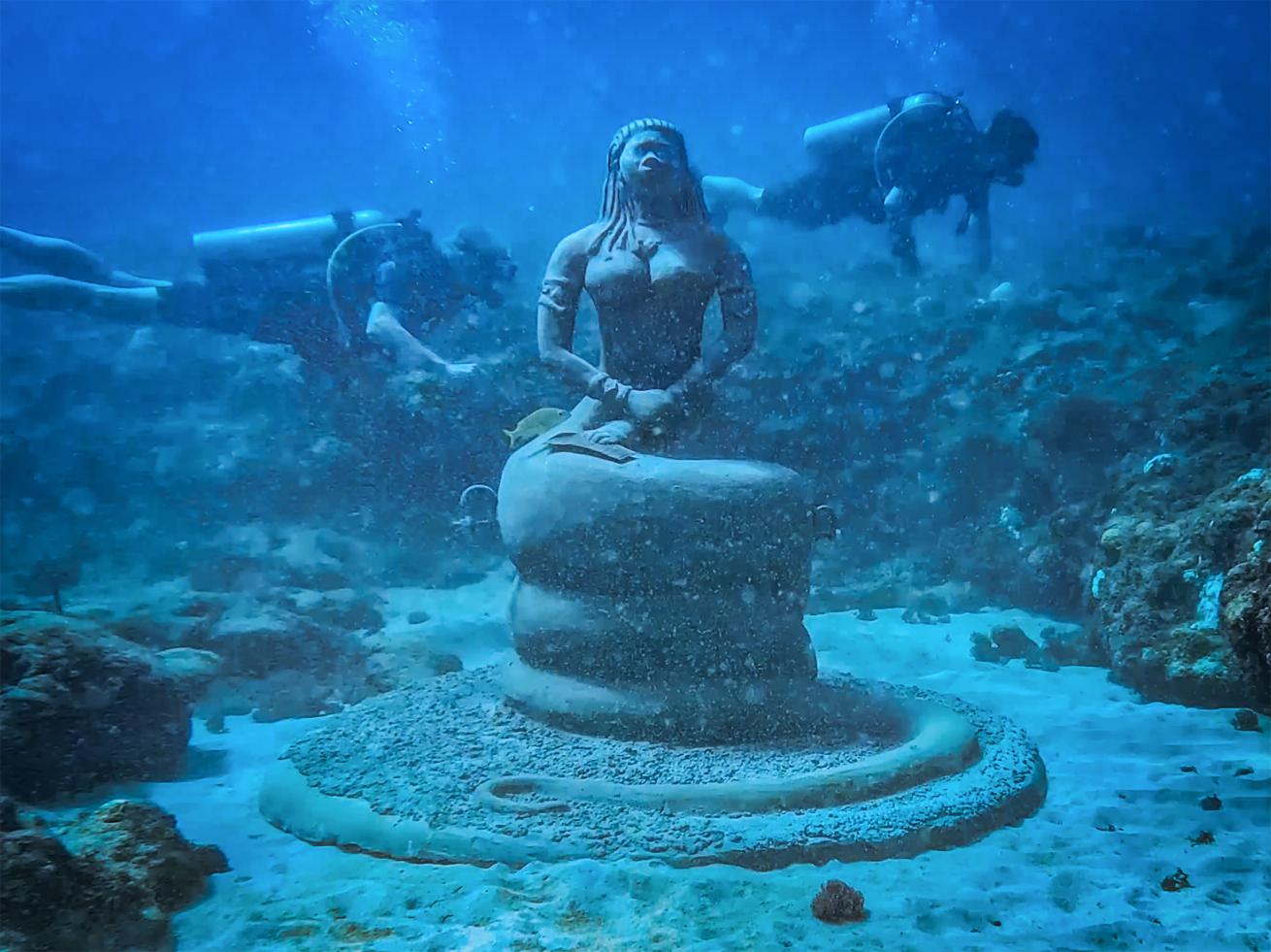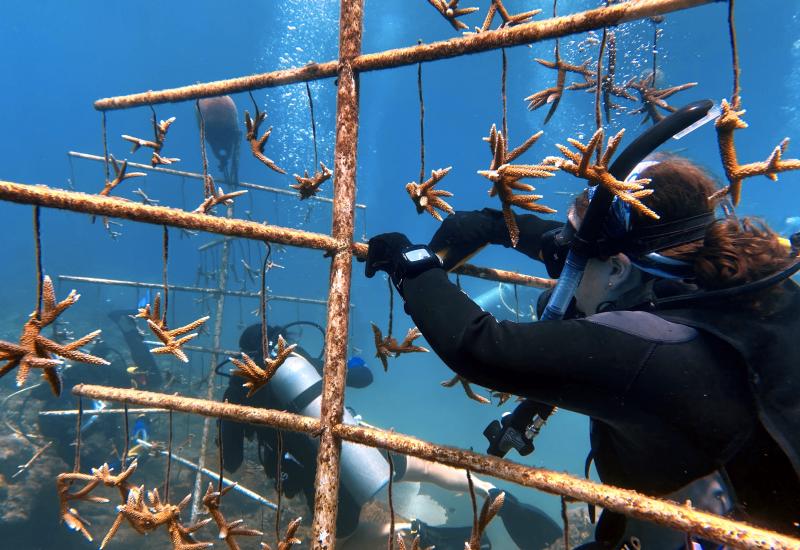The World’s First Underwater Sculpture Park Gets an Upgrade

Photo by Erik TrinidadA detailed sculpture of a "Pretty Mas" woman in Jason deCaires Taylor's "The Coral Carnival."
Jason deCaires Taylor has come a long way since he started transforming coral reefs by creating underwater sculpture galleries. His first project, the Underwater Sculpture Park installed in Grenada’s Molinere Bay in 2006, was the first of its kind, drawing acclaim from around the world. It inadvertently spearheaded a movement for others to create more underwater galleries as artificial reefs, including the recently opened Art Reef off the coast of Algarve, Portugal. Over the past 17 years, Taylor himself has moved on from the Caribbean to imagine and create several more underwater sculpture parks around the globe—from the Gulf of Mexico to the Mediterranean, the Canary Islands to the Maldives—but his latest project has brought him back to Grenada where it all began, with over 30 new sculptures added to the original park.
Terrestrial Beginnings
The British artist, who had studied environmental art at the Camberwell College of Arts, always had the idea of sculpting for the underwater space. When he found himself in Grenada working as a scuba instructor, his idea started to come to fruition—especially after Hurricane Ivan ravaged the Caribbean nation in 2004.
“Molinere Bay was completely decimated by the hurricane. There was nothing in there, it was just scoured,” recalled Taylor. “But it did have an interesting geography to it. It has lots of channels. And so I thought if we could create something there, it would be an interesting place because there's almost like a gallery.”
With help of the government and local community, Taylor created and submerged a few art installations in Molinere Bay, the most iconic being Vicissitudes, a grand finale piece of 26 children holding hands in a circle. Another piece was The Lost Correspondent, in which he sculpted a lone figure sitting at a desk, with sunken items repurposed from an old office.
Related Reading: Grenada: Are Conservation Festivals the Future of Diving Ecotourism?

Photo by Erik TrinidadSculpture of a cloaked member of the "Vieux Corps" in Jason deCaires Taylor's "The Coral Carnival."
Taylor Isn’t the Only Contributor
About five years after the initial installation, Grenadian authorities commissioned a local artist, Troy Lewis, to craft more sculptures for the park, including “Christ of the Deep,” an underwater Jesus with his arms spread out, and a mermaid of nautical folklore. The park expanded even more with “The Nutmeg Princess'' by Norwegian artist Lene Kilde, depicting an auspicious but elusive woman of Grenadian folklore, and “Bench + Selfie” by German expat René Froehlich, featuring a figure on a bench, taking a selfie with a smartphone.
While these talented sculptors have certainly made an artistic impact underwater, there’s another unspoken contributor: the sea itself. Algae growth allows for coral polyps to develop and gradually add organic elements to the figures, eventually enveloping the bodies and faces to create hauntingly beautiful disfigurations. In a sense, each work of art is actually “fourth dimensional,” with a temporal component contributing coral growth and natural decay.
Related Reading: How to Dive Flower Garden Banks National Marine Sanctuary

Photo by Erik Trinidad"The Lost Correspondent," Jason deCaires Taylor's sculpture from the original Underwater Sculpture Park, gets replaced by a new version with more seaworthy materials.
A Whole New Show
While Taylor’s original pieces continue to evolve at the whim of the sea and time, they’re now joined by 31 new sculptures—which is welcoming news for both scuba diving newcomers and those who’ve seen the park before. One channel of Molinere Bay is now a gallery of Lewis’ work, including The Belair Dancer, depicting a Creole Caribbean folk dancer, and Mama Glo, the protector of all river animals in Grenadian folklore, with a lower body of a snake.
Taylor’s new pieces include an updated version of The Lost Correspondent, which replaces the former one—its repurposed office materials weren’t seaworthy enough—and above all, his latest pièce de résistance, commissioned by Grenada’s Ministry of Implementation & Tourism: The Coral Carnival, the new “finale” of a gallery tour when being led by a divemaster from Dive Grenada. It’s a grand parade of 25 adult figures depicting the Grenadian celebration of Spicemas—biggest carnival of this proclaimed “Spice Island”—with different characters created from molds of actual people, resulting in some incredible details, down to the wrinkles in the bikini tops of the “Pretty Mas” women. Also in the procession: the “Vieux Corps,” figures wearing cloaks and masks that symbolize the loss of identity during slavery, and the “Jab Jabs,” or double devils, which don’t represent incarnations of Satan per se, but rather people dressed as slave masters from the past.

Photo by Erik TrinidadScuba divers swim by "Mama Glo," Grenadian artist Troy Lewis' piece depicting a woman of local folklore with the lower body of a snake.
The Future
Time will tell how the new figures will evolve as marine life makes its mark, but its evolution has already begun; just a few days after the statues had been submerged, Taylor already noticed a thin layer of green algae developing on some of them. He also spotted an octopus finding shelter in one figure, and a trumpet fish trying to blend in with the feathers of a figure’s native headdress.
With ocean temperatures rising and coral bleaching becoming more common, perhaps these artful, artificial reefs depicting human civilization will be the saving grace for marine life, as they remain in a continual state of decay, succumbing to natural elements and organisms that survive.
“I quite like the idea of nature always conquering humans, always taking over us,” said Taylor. “We’re just a step in evolution; we’re not there. Because in the end, we will be the ones that perish. The world will go on.”










